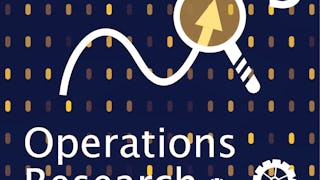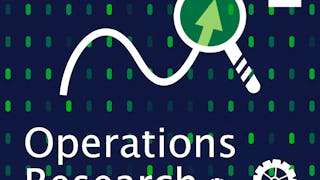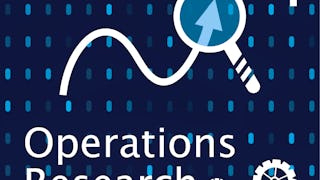Operations Research (OR) is a field in which people use mathematical and engineering methods to study optimization problems in Business and Management, Economics, Computer Science, Civil Engineering, Industrial Engineering, etc. This course introduces frameworks and ideas about various types of optimization problems in the business world. In particular, we focus on how to formulate real business problems into mathematical models that can be solved by computers.

Enjoy unlimited growth with a year of Coursera Plus for $199 (regularly $399). Save now.

Operations Research (1): Models and Applications
This course is part of Operations Research Specialization

Instructor: 孔令傑 (Ling-Chieh Kung)
44,809 already enrolled
Included with
(576 reviews)
Recommended experience
What you'll learn
Formulate different types of mathematical models to tackle optimization problems with business applications.
Technically, the concepts and applications of Linear Programming, Integer Programming, and Nonlinear Programming will be delivered.
Solve an optimization problem with one of the most accessible software: Microsoft Excel.
Skills you'll gain
Details to know

Add to your LinkedIn profile
6 assignments
See how employees at top companies are mastering in-demand skills

Build your subject-matter expertise
- Learn new concepts from industry experts
- Gain a foundational understanding of a subject or tool
- Develop job-relevant skills with hands-on projects
- Earn a shareable career certificate

There are 6 modules in this course
This lecture gives students an overview of what they may expect from this course, including the fundamental concept and brief history of Operations Research. We will also talk about how mathematical programming can be used to solve real-world business problem.
What's included
6 videos1 reading1 assignment
Linear programming (LP) is one of the most important method to achieve the outcome of optimization problems. We can use LP models for various decisions, including production, inventory, personnel scheduling, etc.
What's included
15 videos1 assignment
In many practical areas, some of the optimization problems occur with integrality constraints imposed on some of the variables. Facility location, machine scheduling, and vehicle routing are some examples. Integer Programming (IP) provides a mathematical way to solve these problems.
What's included
15 videos1 assignment
In the real life, many problems involve nonlinearities. Examples include pricing, inventory, and portfolio optimization. For such problems, we may use Nonlinear Programming (NLP) to formulate them into models and solve them.
What's included
15 videos1 assignment
In this lecture, we introduce a real business case that has been solved with Operations Research by the instructor. The problem is for a company to schedule its customer service representatives to minimize the total amount of staff shortage. We will demonstrate the problem, process of conducting an OR study, integer programming formulation, and result.
What's included
9 videos1 assignment
In the final lecture of this course, we will summarize what we have learned. We will also preview what we may learn in future courses.
What's included
3 videos1 assignment
Earn a career certificate
Add this credential to your LinkedIn profile, resume, or CV. Share it on social media and in your performance review.
Instructor

Offered by
Explore more from Algorithms
 Status: Free Trial
Status: Free TrialNational Taiwan University
 Status: Free Trial
Status: Free TrialNational Taiwan University
 Status: Free Trial
Status: Free TrialNational Taiwan University
 Status: Free Trial
Status: Free TrialNational Taiwan University
Why people choose Coursera for their career




Learner reviews
576 reviews
- 5 stars
86.45%
- 4 stars
12.15%
- 3 stars
0.52%
- 2 stars
0%
- 1 star
0.86%
Showing 3 of 576
Reviewed on Jul 3, 2024
good introduction course for the operation research field, with top-down approach learning. Start with practical application and go down to theory in this specialization.
Reviewed on Sep 28, 2022
This course just opened my eyes to real value of mathematical operation in different business and now I am much more competent for jobs which need high knowledge of operational research.
Reviewed on Jun 25, 2022
Great introduction to linear programming, integer programming, and non-linear programming with real life examples.

Open new doors with Coursera Plus
Unlimited access to 10,000+ world-class courses, hands-on projects, and job-ready certificate programs - all included in your subscription
Advance your career with an online degree
Earn a degree from world-class universities - 100% online
Join over 3,400 global companies that choose Coursera for Business
Upskill your employees to excel in the digital economy
Frequently asked questions
To access the course materials, assignments and to earn a Certificate, you will need to purchase the Certificate experience when you enroll in a course. You can try a Free Trial instead, or apply for Financial Aid. The course may offer 'Full Course, No Certificate' instead. This option lets you see all course materials, submit required assessments, and get a final grade. This also means that you will not be able to purchase a Certificate experience.
When you enroll in the course, you get access to all of the courses in the Specialization, and you earn a certificate when you complete the work. Your electronic Certificate will be added to your Accomplishments page - from there, you can print your Certificate or add it to your LinkedIn profile.
Yes. In select learning programs, you can apply for financial aid or a scholarship if you can’t afford the enrollment fee. If fin aid or scholarship is available for your learning program selection, you’ll find a link to apply on the description page.
More questions
Financial aid available,

